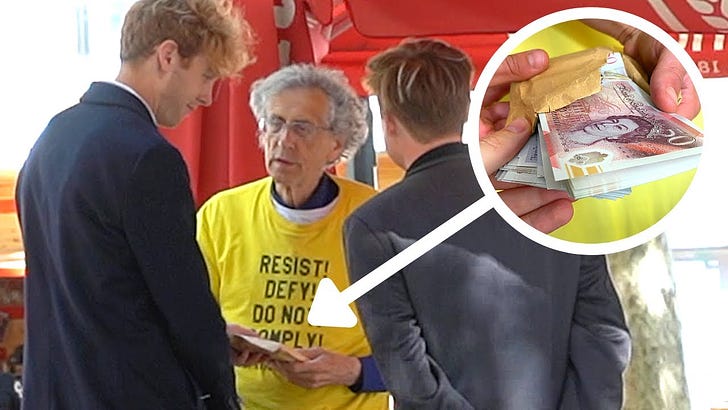Borkowski Weekly Media Trends 06-08-21
Piers Corbyn, The Spectator & Revenge of the Pranksters | Ariana Grande x Fortnite | Vaccine Barbie
Revenge of the Pranksters
As viral social media moments and fake news battle it out for supremacy in the internet, the humble Prankster - often seen as a lower artform- has quietly thrived in the sweetspot of the Venn diagram between these two phenomena.
As a rule, internet pranksters vie for instant, exponential popularity – seeking viral moments to propel their career. In doing so, many “beloved” personalities have crossed the line of acceptability, which has seen viral sensations cancelled, and sometimes past the point of no return; think Sam Pepper, Logan Paul (suicide forest), and even Dapper Laughs (not strictly a prankster, but -rightfully say many- cancelled into oblivion).
And whilst stale, old-school internet pranksters do exist, there have been a few characters bringing some much-needed edge to the ‘artform’.
Having found success exposing Katie Hopkins, Josh Pieters & Archie Manners took on Piers Corbyn – tricking the anti-vaxxer into taking a £10,000 AstraZeneca bribe, which was actually Monopoly money.
Corbyn was forced to aggressively back pedal once the video was aired claiming it was ‘heavily edited’ with ‘dishonest commentary’. It was a well-executed stunt that exposed Piers Corbyn – making him, briefly, a national laughingstock.
In a rich week for pranks it also emerged that the supposed Marcus Rashford hatchet job in the Spectator was a (not very elaborate) hoax.
Linking pranks to the ‘culture wars’ takes a bit more thought and nous, but it attracts a wider, more engaged audience. Exposing mainstream figures for hypocrisy and corruption should be the pranks of tomorrow, not tricking your girlfriend into thinking her son has been killed in an explosion…
Ariana Grande enters the Metaverse
Metaverse platforms, that is, platforms where you control an avatar and interact with others in virtual space, are working to expand their reach beyond their traditional demographics. This is certainly true for Fortnite, which, until recently, has been predominantly young (18-24 and below) and predominantly male (74%). It’s a sharp idea, then, to carry on with their popular concert series with a virtual Ariana Grande concert to go along with her ‘Rift’ tour.
Ariana Grande, whose fanbase is mostly teenage girls (and the occasional male PR consultant no longer in his first youth), will no doubt bring a horde of new users to the platform, which is exactly their ambition. The concert is one of a growing trend of high-profile, high investment digital events on gaming platforms which prove that they are about much more than ‘gaming’ in the narrow sense. Indeed, in the last several years these platforms have come into their own as social spaces and venues in their own right.
The last such event, with rapper Travis Scott, drew an enormous twelve million synchronous viewers (that’s 135 Wembleys). These high profile events are a win-win for the artists and for the platforms, for whom they represent a proof of concept to those skeptical about the role and function they might play beyond the need for them during coronavirus lockdowns.
They are also a great way to sell merchandise via the platform’s digital currencies. The Ariana Grande bundle will go for 2800 ‘V-Bucks’ (£15.99) and will no doubt be a big temptation for many users attending (to ask their parents for). However, it remains to be seen where these big-ticket events (which require big production budgets as well) will become a staple feature of the gaming ecosystem, or whether they give way to—as metaverse experts suggest—longer term, more continuous engagements between artists and brands and the massive user bases these platforms command.
Vaccine Barbie is just the tonic


Who is a Barbie girl in a Barbie world today? Apparently Professor Sarah Gilbert, one of leading scientists behind the Oxford-AstraZeneca COVID-19 vaccine.
Mattel, the maker of Barbie, has come under fire in recent years from feminists and body positivity advocates for promoting a version of femininity that plays into what many see as harmful stereotypes of women. Unrealistic beauty standards aside, the iconic doll has been criticised for failing to engage with gender fluidity and sexuality.
But fixing a reputation crisis within “woke” circles isn’t easy for a doll that’s been a mainstay of what it means to be a girl in the Western world (and beyond) for more than half a century. As Mark Borkowski put it, Barbie is like dog food - “neither a small child or dog can take either product to the till and pay for it themselves.” Consumed by children but purchased by mothers, most of whom belong to a generation far removed from Barbie’s most vocal critics, Mattel’s most popular product toes a fine line between playing to the gallery and protecting its reputation.
In the past, the company has introduced revolutionary products like the infamous David Bowie Starwoman doll that functions simultaneously as a “radical gender bending icon for the young and a reassuring, nostalgic figure of one of Britain’s supreme icons for the old.” The latest addition, the most celebrated woman scientist of our times, is a step in the same direction.
Professor Sarah Gilbert’s miniature replica is everything you might imagine a Barbie doll is not: dressed in a suit, complete with nerdy glasses, ginger hair, and a no-nonsense expression, she’s a far cry from the blond-haired blue-eyed girl of antiquity. And her introduction to Mattel’s increasingly diverse dollhouse has invited praise even from Barbie’s fiercest critics, firmly establishing Barbie’s place as the doll we all love to hate but simply cannot ignore.



